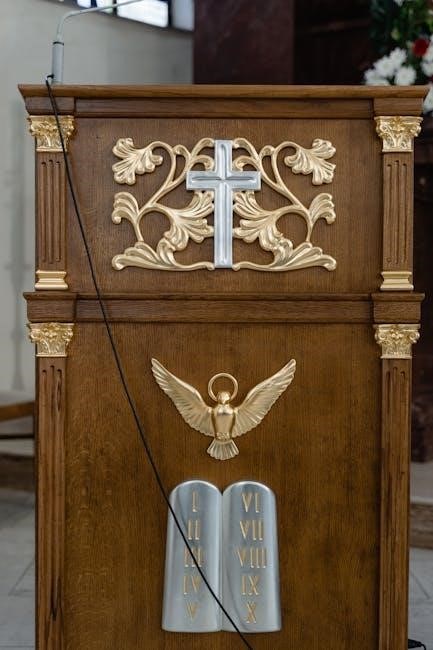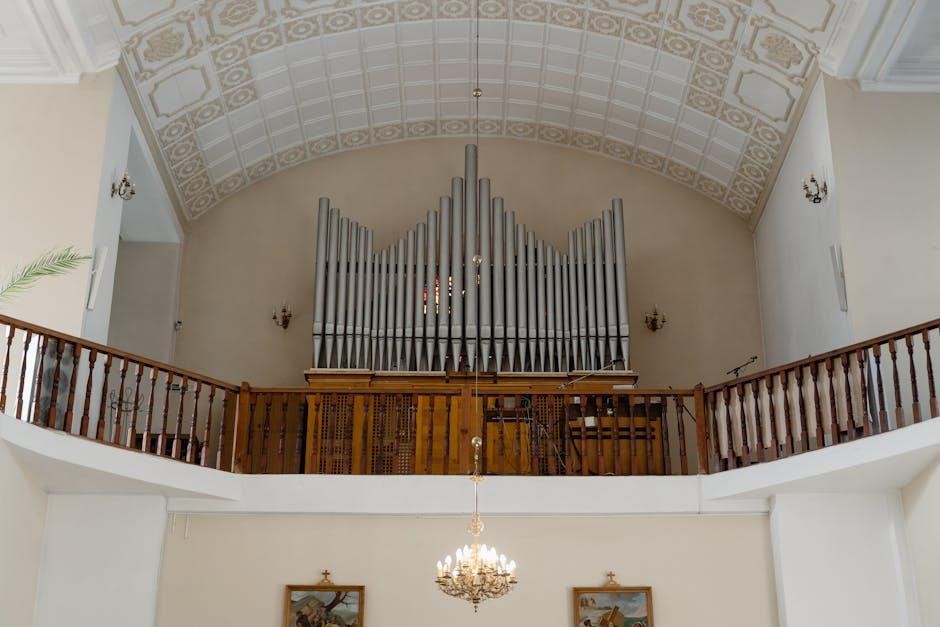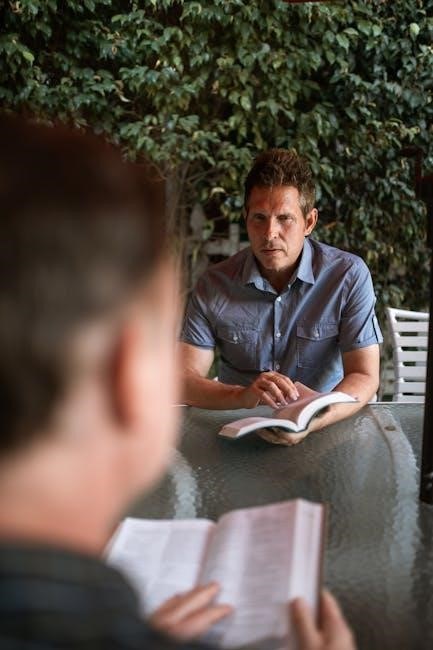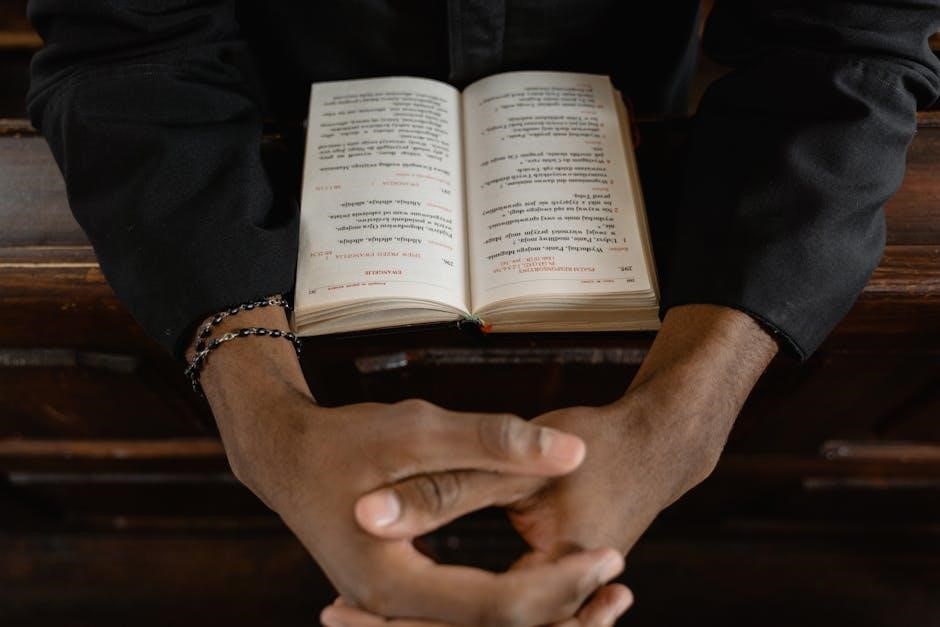
“O God, Beyond All Praising” is a majestic hymn based on Gustav Holst’s Thaxted melody, arranged for SATB voices, celebrating God’s boundless glory and mercy in worship.

1.1 Overview of the Hymn
“O God, Beyond All Praising” is a powerful hymn written by Michael Perry, set to the iconic Thaxted melody from Gustav Holst’s The Planets. The hymn is structured in three verses, each celebrating God’s boundless love, mercy, and splendor. Its grand arrangement, often featuring brass and organ accompaniment, evokes a sense of awe and reverence; The lyrics emphasize divine attributes and humanity’s response to God’s grace. This hymn is widely used in worship services, blending traditional and modern elements to inspire congregational praise and reflection.
1.2 Historical Context
The hymn “O God, Beyond All Praising” was written by Michael Perry in 1982, set to the iconic Thaxted melody from Gustav Holst’s Jupiter movement, composed in 1916. Perry crafted the lyrics to reflect themes of divine mercy, love, and humanity’s awe-inspired response to God. The hymn gained prominence in Christian worship due to its powerful blend of theology and music, becoming a staple in liturgical and congregational settings. Its use in significant events, such as Justice Antonin Scalia’s 2016 memorial service, underscores its enduring relevance and emotional resonance in modern worship traditions.
1.3 Composer and Lyricist
Gustav Holst, a renowned British composer, created the Thaxted melody for Jupiter in 1916. Michael Perry, a contemporary hymn writer, later crafted the lyrics in 1982. Perry’s verses resonate with themes of divine glory and mercy, while Holst’s melody provides a grand, orchestral foundation. Their collaboration bridges classical and sacred music, making the hymn a beloved choice for worship, concerts, and memorials. Perry’s work, administered by Hope Publishing Co., has enriched Christian worship globally, while Holst’s legacy continues through this timeless piece.

Structure and Composition
The hymn features a grand orchestral arrangement, including organ, brass quintet, and timpani. Its structure includes three verses, each praising God’s glory, with SATB vocals and instrumental accompaniment.
2.1 Musical Notation and Arrangement
The hymn is arranged for SATB voices, congregation, and organ, with optional brass quintet and timpani. The Thaxted melody by Gustav Holst provides a grand, orchestral feel. The score includes dynamic markings, tempo indications, and crescendos, creating a powerful worship experience. The arrangement is set in Broadly (ca. 60) tempo, with pedal crescendo markings for the organ. Instrumental parts are available separately, allowing flexibility for different performance settings. The notation is clear and structured, making it accessible for both choral and congregational participation, while maintaining the majestic quality of Holst’s original composition.
2.2 Vocal Parts: Soprano, Alto, Tenor, and Bass
The hymn features SATB vocals, blending harmonies to reflect the text’s grandeur. Sopranos lead with the melody, while altos, tenors, and basses provide rich harmonic support. Each part is distinct yet cohesive, creating a unified sound. The score includes dynamic and phrasing cues, guiding singers to emphasize key phrases. The arrangement balances vocal ranges, ensuring accessibility for congregations and choirs alike. The interplay between vocal sections enhances the hymn’s majestic quality, making it suitable for both traditional and contemporary worship settings. The vocal parts are thoughtfully composed to inspire and engage all participants in praise.
2.3 Instrumental Accompaniment
The hymn is accompanied by organ, with optional brass quintet and timpani, enhancing its grandeur. The organ provides a robust foundation, while brass adds triumphant accents. Timpani emphasize rhythmic dynamics, enriching the musical texture. The arrangement allows for flexibility, with instrumental parts available separately. This combination creates a powerful, uplifting sound, ideal for congregational singing and special performances. The instrumental elements complement the vocal parts, heightening the emotional impact and celebrating the hymn’s themes of divine praise and mercy. The score’s versatility makes it adaptable to various worship settings and musical resources.

Lyrics and Theological Themes
The hymn’s lyrics express profound gratitude and celebrate God’s boundless mercy, divine attributes, and amazing love, drawing inspiration from biblical references and themes of worship.
3.1 Biblical References and Inspirations
The hymn draws inspiration from biblical themes of divine praise and mercy, with lyrics reflecting God’s transcendent nature. Specific references include Romans 11, which frames the hymn’s text, and 1 Corinthians 15:35-49, influencing stanza 2. The song emphasizes worship, gratitude, and God’s boundless love, aligning with scriptural teachings on praising God’s glory and mercy. Biblical imagery of God as King, Judge, and Father underpins the hymn’s theological foundation, blending reverence with joyful celebration of divine attributes.
3.2 Praise and Worship Themes
The hymn “O God, Beyond All Praising” is a powerful expression of praise and worship, emphasizing God’s glory and mercy. Its lyrics, set to Gustav Holst’s Thaxted melody, inspire awe and devotion. The song structure builds from reverence to joyful celebration, encouraging believers to acknowledge God’s boundless love and splendor. Themes of gratitude and worship are central, with verses calling for praise and adoration, reflecting a deep theological commitment to honoring God’s majesty and grace.
3.4 Divine Attributes and Mercy
The hymn “O God, Beyond All Praising” profoundly highlights God’s divine attributes and mercy, emphasizing His boundless love and splendor. The lyrics celebrate God’s sovereignty and grace, portraying Him as a gracious Savior who accepts the love and worship offered by His people. Themes of divine mercy are woven throughout the verses, with references to God’s countless mercies and His role as a loving Father. The hymn’s theological depth underscores the majesty of God, inviting believers to reverence and adore Him for His infinite goodness and redemptive love, central to its message of worship and devotion.

Performance and Use in Worship
“O God, Beyond All Praising” is often performed with SATB voices, organ accompaniment, and optional brass quintet and timpani, enhancing its grandeur in worship settings.
4.1 Congregational Singing
“O God, Beyond All Praising” is a powerful hymn often sung by congregations in worship services. Its grand melody, based on Gustav Holst’s Thaxted, elevates collective praise. The hymn’s structure, with verses and chorus, makes it accessible for congregational singing. The optional brass quintet and timpani add a majestic sound, enhancing the worship experience. Many churches incorporate it into liturgical celebrations, especially on occasions requiring triumphant and joyful expressions of faith. The hymn’s timeless message of divine glory resonates deeply with worshippers, fostering unity and devotion in communal singing.
4.2 Liturgical Context
“O God, Beyond All Praising” is frequently used in grand liturgical settings, complementing moments of high celebration. The hymn’s triumphant tone aligns with festivals, dedications, and special services. Its biblical references, particularly from Romans 11, provide a theological foundation for worship. The inclusion of brass and organ enhances the ceremonial atmosphere, making it suitable for processions or dedicatory rites. This hymn is often chosen for events requiring a robust expression of praise, ensuring its place in both traditional and contemporary liturgical practices across various Christian traditions.
4.3 Special Arrangements and Instrumental Versions
The hymn is often enhanced with special arrangements, including optional brass quintets and timpani, adding a grandeur that complements its triumphant melody. Instrumental versions, such as piano, guitar, and flute adaptations, are widely available, offering versatility for different worship settings. These arrangements allow for both grand orchestral performances and intimate instrumental renditions, making the hymn accessible to various musical contexts. The sheet music for these versions is readily accessible online, enabling musicians to tailor the piece to their specific needs and audiences.

Cultural and Historical Significance
Gustav Holst’s iconic melody from “Jupiter” elevates the hymn to a timeless classic, resonating in worship globally. Its use in memorable events underscores its enduring cultural and spiritual impact.
5.1 Gustav Holst’s Contribution to Sacred Music
Gustav Holst’s renowned Thaxted melody, from his orchestral suite Jupiter, has become a cornerstone of sacred music. Its grandeur and emotional depth make it a perfect fit for “O God, Beyond All Praising.” Holst’s work bridges classical and religious traditions, creating a sense of awe and reverence in worship. His compositions are celebrated for their ability to inspire and uplift, leaving a lasting legacy in both liturgical and concert settings. This hymn exemplifies his enduring influence on sacred music globally.
5.2 Modern Interpretations and Performances
“O God, Beyond All Praising” remains a beloved hymn in modern worship, with its timeless melody and powerful lyrics continuing to inspire congregations worldwide. Available in PDF and digital formats, the hymn is easily accessible for contemporary performances. Musicians and worship leaders often incorporate instrumental arrangements, including piano, guitar, and flute, to enrich its presentation. Its versatility allows for both traditional and innovative interpretations, making it a staple in diverse worship settings. The hymn’s enduring popularity is evident in its widespread use across global communities, where it is performed with passion and reverence, bridging generations in shared worship.
5.3 Impact on Christian Worship
“O God, Beyond All Praising” has profoundly influenced Christian worship, offering a powerful expression of devotion and praise. Its majestic melody, derived from Holst’s Thaxted, elevates congregational singing, while its lyrics emphasize God’s boundless mercy and love. The hymn’s versatility allows it to resonate in both traditional and contemporary worship settings, making it a unifying force across diverse Christian communities. Its widespread use in liturgical services, memorials, and celebrations underscores its enduring relevance. The hymn’s ability to inspire awe and gratitude continues to enrich worship experiences, fostering a deeper connection with the divine for believers worldwide.

Sheet Music Availability and Formats
Sheet music for “O God, Beyond All Praising” is available in PDF and digital formats, including SATB scores, instrumental parts, and free resources for worship communities.
6.1 PDF Downloads and Digital Access
The hymn “O God, Beyond All Praising” by Gustav Holst is widely available in PDF format for digital access. Platforms like Musicnotes and Sheet Music Plus offer downloadable scores for SATB voices, piano, and instrumental arrangements. These digital files provide convenient access for worship leaders, choirs, and musicians to practice and perform the piece. Many websites also offer free previews, allowing users to review the sheet music before purchasing. Additionally, some platforms enable sharing and printing options, making it easy to distribute among choir members or instrumentalists. This digital accessibility ensures the hymn remains a popular choice for modern worship settings.
6.2 Instrumental Parts and Scores
The instrumental parts for “O God, Beyond All Praising” are available in PDF format, including arrangements for brass quintet, timpani, and organ. These scores complement the SATB vocal parts, enhancing the hymn’s grandeur. Publishers like Hope Publishing Co. offer complete sets, ensuring compatibility for ensemble performances. The brass quintet adds a triumphant tone, while the timpani underscores the majestic theme. Organ scores provide a foundational accompaniment, blending seamlessly with vocal harmonies. These instrumental arrangements are adaptable for various worship settings, from congregational singing to orchestral performances, making the hymn a versatile choice for diverse liturgical needs and musical interpretations.
6.3 Free Resources and Community Sharing
Free sheet music for “O God, Beyond All Praising” is widely available in PDF format, accessible for piano, guitar, flute, and other instruments. Online platforms like sheet music communities and forums offer downloads, fostering collaboration among musicians. Worship leaders and enthusiasts share arrangements, ensuring the hymn’s reach expands. These resources are often shared freely, encouraging adaptation and performance in various worship settings. The availability of free scores has made the hymn accessible to congregations and performers worldwide, promoting its enduring popularity and spiritual impact. Community sharing highlights the hymn’s universal appeal and adaptability.

Performance Considerations
Performance of “O God, Beyond All Praising” requires careful attention to vocal balance, dynamics, and tempo. The hymn’s majestic arrangement demands precise control over crescendos and decrescendos, ensuring a powerful yet reverent execution.
7.1 Vocal Techniques and Choral Directing
Effective performance of “O God, Beyond All Praising” requires precise vocal techniques and choral directing. Conductors should emphasize dynamic balance, ensuring soprano and tenor sections project clearly while altos and basses provide rich harmonic support. Proper breath control is essential for sustained crescendos, particularly in the Thaxted melody’s climactic sections. Attention to diction and phrasing is crucial for lyrical clarity, especially in verses praising God’s mercy and love. Directors should guide the choir to maintain a reverent yet powerful tone, blending seamlessly with instrumental accompaniment to enhance the hymn’s emotional and spiritual impact.
7.2 Organ and Brass Accompaniment
The organ provides a robust foundation for “O God, Beyond All Praising”, with its Thaxted melody soaring above rich harmonies. Brass quintet accompaniment enhances the hymn’s grandeur, particularly in crescendos and climactic sections. The organ’s pedal crescendo adds depth, while brass instruments like trumpets and trombones punctuate triumphant phrases. Timpani accents emphasize rhythmic intensity, creating a majestic atmosphere. Directors should balance organ registrations to support vocal parts without overpowering them, ensuring a cohesive blend between choir, organ, and brass for a thrilling worship experience.
7.3 Timpani and Percussion Roles
The timpani play a pivotal role in “O God, Beyond All Praising”, adding rhythmic intensity and dynamic contrast. Used sparingly, they underscore key moments, such as the hymn’s crescendos and triumphant declarations. Percussion elements, including cymbals and tambourines, are often reserved for climactic sections to emphasize praise and adoration. Proper tuning and precise execution are essential to maintain the hymn’s grandeur without overwhelming the ensemble. Their strategic use elevates the overall worship experience, aligning with the hymn’s themes of divine majesty and boundless praise.

Legacy and Memorial Uses
O God, Beyond All Praising has been featured in notable events, including Justice Antonin Scalia’s memorial, showcasing its profound impact in solemn and celebratory contexts.
8.1 Notable Performances and Events
O God, Beyond All Praising has been performed at significant events, including the memorial service for Justice Antonin Scalia, showcasing its solemn grandeur. Its powerful melody, derived from Holst’s Jupiter, evokes awe and reverence. The hymn is often featured in state ceremonies, religious gatherings, and commemorative services, highlighting its universal appeal. Performances frequently include orchestral accompaniment, emphasizing its majestic qualities. Such events underscore its role in honoring milestones and providing solace, reflecting its enduring legacy in worship and remembrance.
8.2 Use in Memorial Services
O God, Beyond All Praising is frequently chosen for memorial services due to its solemn and uplifting tone. Its majestic melody, based on Holst’s Thaxted, provides a fitting backdrop for reflection and remembrance. The hymn’s themes of divine mercy and eternal praise resonate deeply during times of mourning. Notably, it was performed at the memorial service for Justice Antonin Scalia, where its grandeur and emotional depth offered solace to attendees. The hymn’s orchestral arrangement, often featuring brass and timpani, adds a sense of gravitas, making it a popular choice for honoring the deceased and celebrating their legacy.
8.3 Cultural and Historical Milestones
O God, Beyond All Praising holds significant cultural and historical value as a hymn deeply rooted in sacred music traditions. Its melody, derived from Gustav Holst’s iconic “Thaxted” from The Planets, has become synonymous with grandeur and divine praise. The hymn has been featured in notable national events and state functions, further cementing its cultural impact. Its performance at Justice Antonin Scalia’s memorial service exemplifies its role in solemn, high-profile ceremonies. By bridging traditional hymnody with orchestral splendor, it continues to inspire worship across generations, marking it as a timeless piece in Christian musical heritage.

Resources for Further Study
Explore sheet music platforms, online forums, and academic articles for deeper insights into the hymn. YouTube tutorials and community discussions offer practical tips for performance and arrangement.
9.1 Recommended Reading and Listening
For a deeper understanding, explore books on sacred music history, such as The Oxford Handbook of Hymn Studies, and listen to recordings by renowned choirs like the Cambridge Singers. Online platforms like YouTube offer performances and analysis of “O God, Beyond All Praising.” Additionally, sheet music platforms provide scores and arrangements for study. Podcasts discussing hymnology and interviews with musicologists can further enrich your appreciation of this piece. These resources offer insights into the hymn’s theological depth and musical craftsmanship, making them invaluable for scholars and enthusiasts alike.
9.2 Online Communities and Forums
Engage with online communities like Reddit’s r/Hymns or r/ChurchMusic, where enthusiasts discuss hymns and share insights. Facebook groups dedicated to sacred music and forums like Hymnary.org offer rich discussions on “O God, Beyond All Praising.” These platforms foster connections among musicians, theologians, and worship leaders, providing a space to explore interpretations, arrangements, and performances. Users often share sheet music, recordings, and personal experiences, making these forums invaluable for learning and collaboration. Active participation can deepen your understanding and appreciation of this beloved hymn.
9.3 Sheet Music Platforms and Marketplaces
Sheet music for “O God, Beyond All Praising” is widely available on platforms like Musicnotes, SheetMusicPlus, and Scribd. These marketplaces offer PDF downloads for piano, guitar, and instrumental arrangements, catering to various skill levels. Many platforms provide free previews, enabling users to review compositions before purchasing. Additionally, sites like JW Pepper and Hope Publishing specialize in sacred music, offering high-quality scores for worship settings. These resources ensure accessibility for musicians, worship leaders, and enthusiasts seeking to perform or study the hymn.